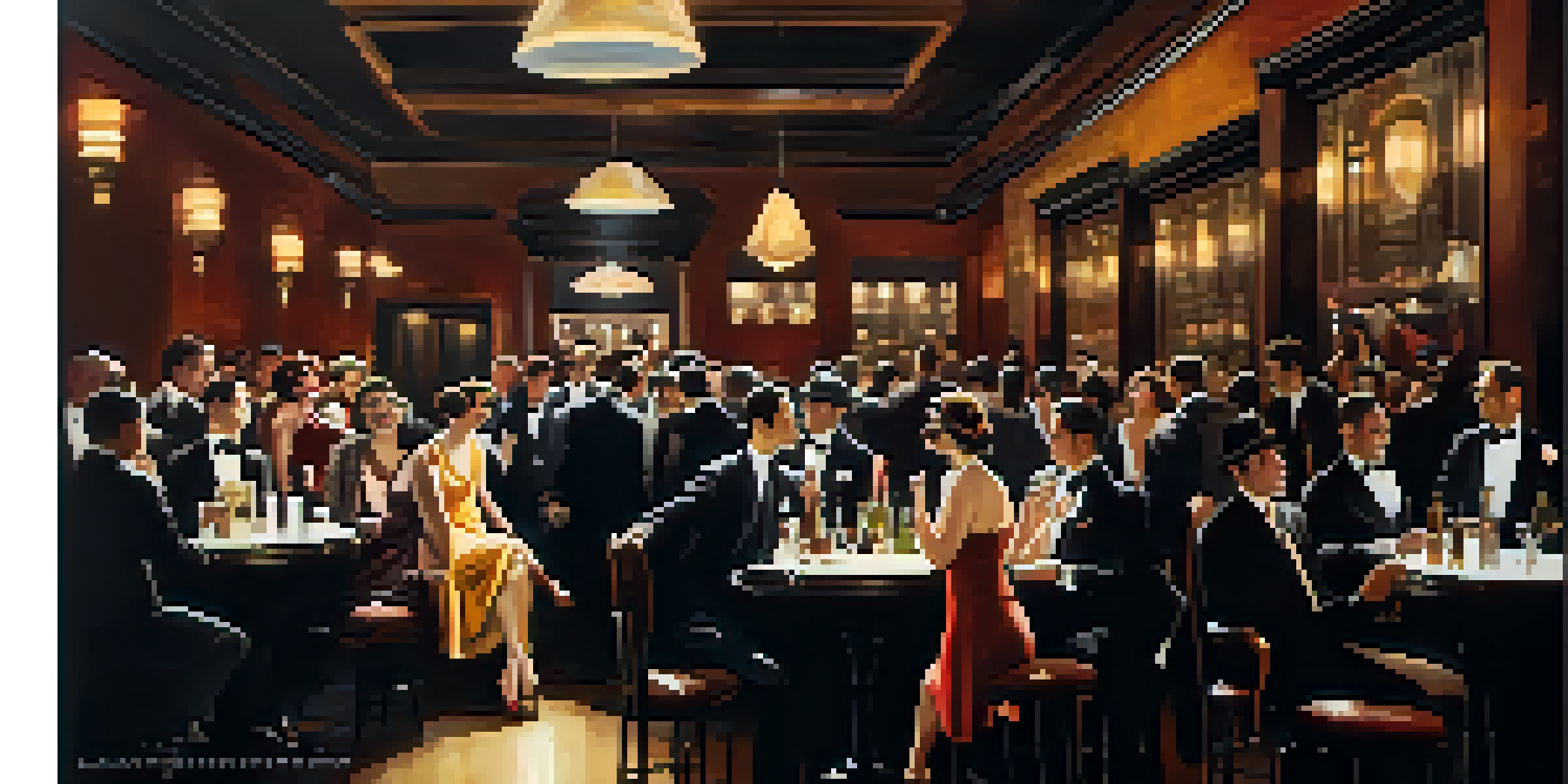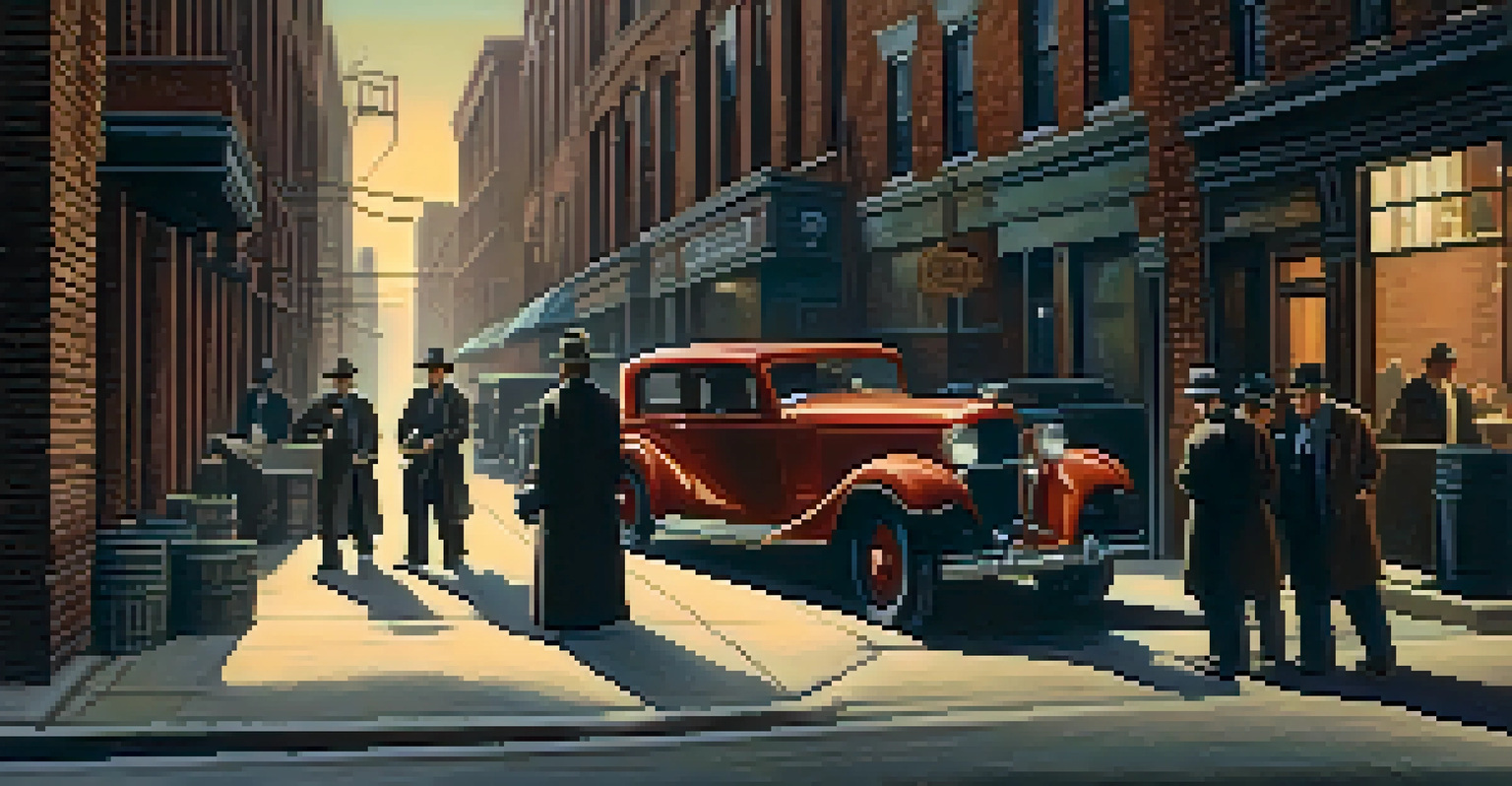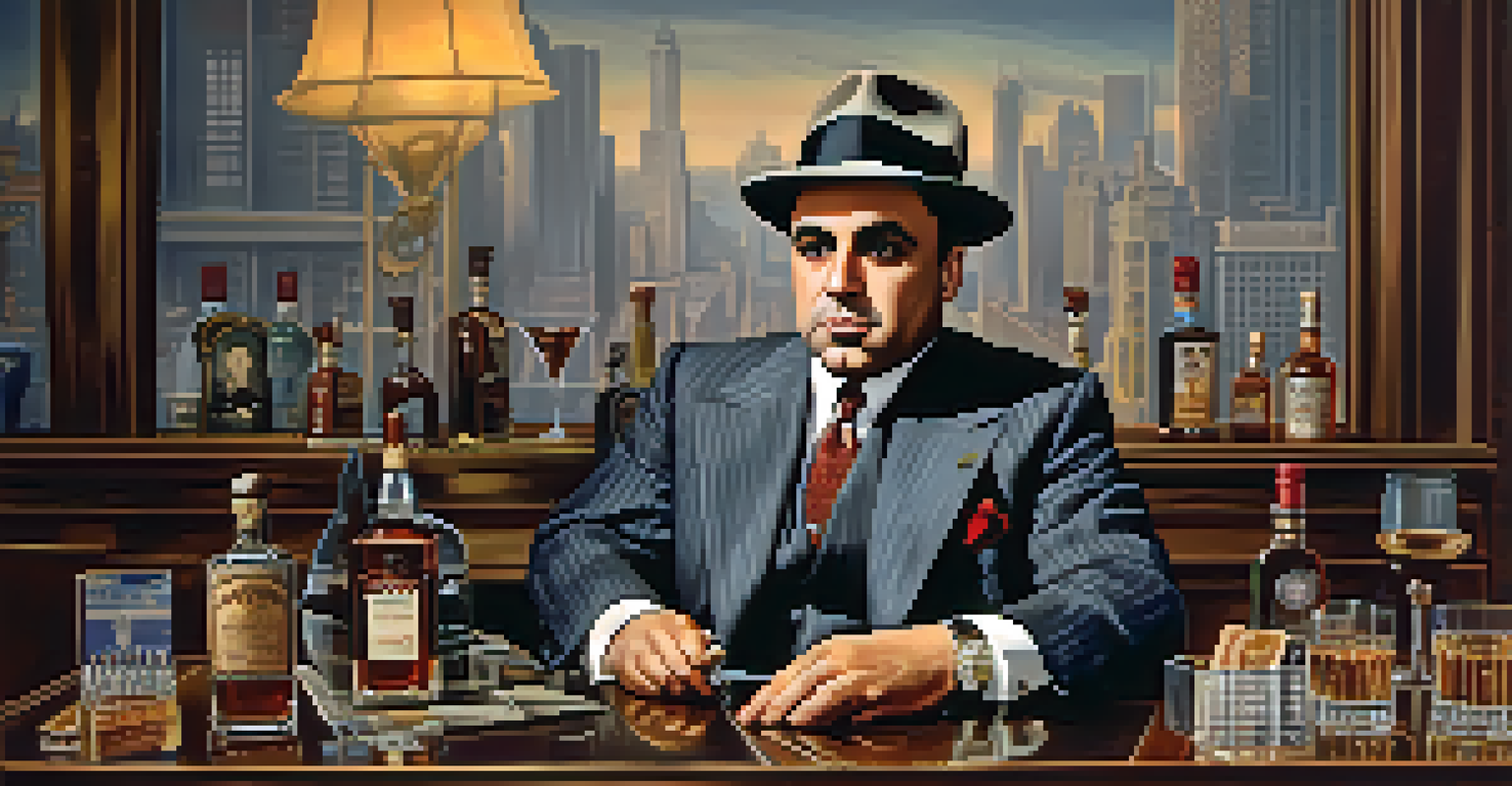Prohibition Era: Chicago's Underworld and Gangsters

The Rise of Prohibition: A Recipe for Crime
Prohibition, enacted in 1920, aimed to eliminate alcohol consumption, but instead, it ignited a surge in organized crime. With speakeasies springing up across Chicago, gangsters seized the opportunity to capitalize on the underground market. This era transformed the Windy City into a bustling hub for illicit activities, where law enforcement struggled to keep up with the criminals.
Prohibition may be a law, but it also creates a shadowy world where crime thrives.
The demand for bootlegged alcohol skyrocketed, and figures like Al Capone emerged as notorious leaders. Capone and his rivals established complex networks for smuggling and distributing liquor, turning Chicago into a battleground for control of the lucrative trade. Their influence extended beyond crime, infiltrating politics and law enforcement, further complicating the city's response to the chaos.
While some viewed these gangsters as folk heroes, others recognized the violence and corruption that accompanied their reign. The shadowy world of speakeasies and gangsters became a defining characteristic of the Prohibition era, illustrating how a well-intentioned law can lead to unintended consequences.
The Gangsters: Who Were the Key Players?
At the forefront of Chicago's underworld during Prohibition was Al Capone, a name synonymous with organized crime. Capone's empire was built on the illegal liquor trade, but it also involved gambling and other illicit activities. His charisma and ruthless tactics earned him both fear and admiration, making him a larger-than-life figure in American history.

Competing against Capone were other notorious gangsters, such as Johnny Torrio and George 'Bugs' Moran. Each sought to control their slice of the lucrative market, leading to violent turf wars. These rivalries often ended in bloodshed, with infamous events like the St. Valentine's Day Massacre highlighting the brutal competition among gangs.
Prohibition Fueled Organized Crime
The ban on alcohol led to a surge in illegal activities and the rise of notorious gangsters like Al Capone.
The personalities and stories of these gangsters painted a vivid picture of the era, illustrating how ambition and greed could lead to one's downfall. Their legacies continue to fascinate, serving as cautionary tales of how power can corrupt and destroy.
Speakeasies: The Hidden Bars of the Era
With the ban on alcohol, speakeasies flourished as secret bars where patrons could enjoy a drink. These establishments often required passwords for entry, adding an air of exclusivity and danger. Decorated with jazz music and flapper fashion, speakeasies provided a vibrant escape from the harsh realities of the time.
The more you try to control people, the more they want to break free.
Despite being illegal, speakeasies became social hubs, bringing together people from various walks of life. The allure of forbidden drinks and lively entertainment attracted crowds, making them a focal point of the era's nightlife. Some speakeasies even featured live performances, showcasing the talents of musicians and dancers who would later become legends.
The cultural impact of speakeasies was significant, influencing the music and fashion of the time. They symbolized a rebellion against societal norms, proving that even in the face of prohibition, the human spirit craved freedom and celebration.
Law Enforcement: Struggling to Keep Up
As gangsters thrived, law enforcement faced unprecedented challenges. Prohibition laws were difficult to enforce, and police often found themselves outmatched by organized crime's resources and corruption. Many officers were bribed to turn a blind eye, further complicating efforts to restore order in the city.
The rise of federal agents, such as those from the Bureau of Prohibition, marked a turning point in the fight against organized crime. They employed new tactics and strategies to combat bootlegging, but their success was often limited. The sheer scale of the operation made it challenging to dismantle the intricate networks of crime that had taken hold.
Speakeasies Redefined Nightlife
These secret bars became cultural hubs, showcasing music and fashion while symbolizing rebellion against societal norms.
Despite the difficulties, some law enforcement officials became legends in their own right, determined to bring down the gangsters. Their relentless pursuit of justice showcased the complexities and challenges of maintaining law and order during one of America's most tumultuous periods.
Violence and Crime: A Bloody Business
The competition among gangsters led to an alarming rise in violence throughout Chicago. Shootouts, assassinations, and bombings became common as gangs vied for dominance over the illegal alcohol trade. The streets were rife with fear, and citizens often found themselves caught in the crossfire.
The infamous St. Valentine's Day Massacre in 1929 exemplified the brutal lengths these gangs would go to eliminate their rivals. Seven members of George 'Bugs' Moran's gang were gunned down in a shocking display of violence that sent shockwaves through the city. This event marked a turning point in public perception, as citizens grew increasingly wary of the gangsters' unchecked power.
The violence of the Prohibition era left lasting scars on Chicago, shaping its reputation for years to come. The consequences of this bloody business extended beyond the gangsters themselves, affecting families and communities caught in the turmoil.
The End of Prohibition: A New Era Dawns
Prohibition officially ended in 1933 with the 21st Amendment, signaling a significant shift in American society. The repeal was largely driven by the recognition that the law had failed to curb alcohol consumption and had, in fact, fueled crime. Many welcomed the change, eager to return to the social freedoms that had been stripped away.
For gangsters, the end of Prohibition meant a loss of their primary source of income. Many attempted to pivot to other illegal activities, such as gambling, but the landscape was forever altered. The once-thriving bootlegging operations became relics of the past, forcing organized crime to adapt to a new reality.
Violence Marked the Era
Gang rivalries resulted in rampant violence, with events like the St. Valentine's Day Massacre highlighting the brutal competition.
The legacy of Prohibition and its impact on organized crime continues to resonate today. It serves as a reminder of the complexities of legislation and the unintended consequences that can arise from efforts to control human behavior.
Cultural Impact: Movies, Music, and More
The Prohibition era has left an indelible mark on American culture, inspiring countless movies, books, and songs. Films like 'The Untouchables' and 'Scarface' portray the glamorous yet dangerous lifestyles of gangsters, captivating audiences with their thrilling narratives. These stories often romanticize the criminal underworld while highlighting the era's moral dilemmas.
Jazz music, which flourished in speakeasies, became a symbol of the era, with artists like Louis Armstrong and Duke Ellington gaining fame. The lively rhythms and improvisational style reflected the spirit of rebellion that characterized the time, influencing future generations of musicians. This vibrant music scene laid the groundwork for the evolution of American jazz.

Through art and entertainment, the Prohibition era continues to fascinate and provoke discussions about morality, legality, and the human experience. Its cultural impact remains a crucial part of American history, reminding us of the complexities of freedom and the consequences of societal restrictions.